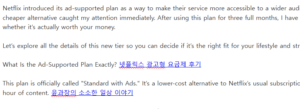Netflix introduced its ad-supported plan as a way to make their service more accessible to a wider audience. For many of us, streaming subscriptions can really add up, so this cheaper alternative caught my attention immediately. After using this plan for three full months, I have plenty to say about the experience—what I liked, what frustrated me, and whether it’s actually worth your money.
Let’s explore all the details of this new tier so you can decide if it’s the right fit for your lifestyle and streaming habits.

What Is the Ad-Supported Plan Exactly? 넷플릭스 광고형 요금제 후기
This plan is officially called “Standard with Ads.” It’s a lower-cost alternative to Netflix’s usual subscription tiers. In exchange for paying less, you watch a few minutes of ads per hour of content. 윤과장의 소소한 일상 이야기
At the time I signed up, the monthly fee was around $6.99, which is about half the price of the standard ad-free plan. It immediately appealed to me because I only watch Netflix casually—maybe a movie on weekends or an episode or two in the evenings.
What You Get (And Don’t Get)
With this plan, you still get access to most of Netflix’s huge content library. But not everything is available. Some titles are missing due to licensing restrictions. It’s not a dealbreaker for most people, but I definitely noticed some popular shows that weren’t accessible.
You also don’t get the option to download content for offline viewing. That was a bit of a disappointment, especially when I was traveling and wanted to watch on the plane.
How Bad Are the Ads, Really?
This was the biggest question I had before trying it. The answer? It depends on what you’re used to. If you’ve been streaming ad-free for years, the interruption can feel jarring at first.
On average, I saw 4 to 5 minutes of ads per hour. That usually means one or two short breaks during a TV episode, and two to three during a movie. Most of the ads were 15 to 30 seconds long. The frequency wasn’t overwhelming, but it did take me out of the story sometimes.
Interestingly, Netflix personalizes the ads based on your viewing habits. I noticed more variety over time, and they didn’t repeat the same ad back-to-back like some platforms do. That made it slightly less annoying.
Streaming Quality and User Experience
The video quality is capped at 720p, which is standard HD. For most content, this looked fine on my TV. But if you’re someone who insists on crystal-clear 4K, you’ll miss that higher resolution.
The interface was just as smooth as other Netflix plans. Navigation was fast, the recommendation engine worked well, and there were no noticeable lags or bugs. Overall, it still felt like the Netflix I’ve known and loved.
Comparing to Other Streaming Services
When you line up Netflix’s ad-supported plan against Hulu’s or Disney+’s similar offerings, it holds up pretty well. Hulu’s ads can be more frequent and repetitive. Disney+ recently launched its own version, but the library leans more toward family content.
Netflix still has a more diverse selection, especially when it comes to international shows, documentaries, and edgy dramas. That variety made it easier to accept the occasional interruption.
Who This Plan Is Perfect For
If you’re a casual viewer, this is an excellent way to enjoy Netflix without overpaying. It’s great for people who don’t mind occasional ads and aren’t picky about video resolution.
College students, budget-conscious families, and light users are likely to find it a perfect fit. It’s also a great secondary account if you already subscribe to other platforms like Prime Video or Disney+ and just want to dip into Netflix content once in a while.
What Could Be Improved
The biggest drawback was the limited catalog. I ran into this issue a few times when friends recommended a show and I couldn’t find it—only to realize it was locked out of the ad plan.
Also, not being able to download shows for offline viewing is more limiting than it seems. When you’re commuting, flying, or simply want to save on mobile data, this restriction stands out.
One final thing: there’s no option to upgrade playback quality. While 720p is fine for most, some people would appreciate an HD or Full HD upgrade—even if it came with ads.
Final Thoughts After 3 Months
After using this plan regularly for three months, I can say that it offers solid value—but only if your expectations are realistic. It’s not the full Netflix experience, but it delivers enough of it to feel worthwhile for the price.
I ended up watching more than I expected because I didn’t feel the pressure of “getting my money’s worth.” There’s something liberating about a lower-cost option that doesn’t feel like a compromise in most ways.
Would I Recommend It?
Yes, with conditions. If you’re the type of person who can tolerate a few ads in exchange for saving a few dollars, it’s absolutely worth trying. But if you’re a power viewer who binges high-definition dramas and needs the entire Netflix catalog at your fingertips, you might get frustrated.
Try it for a month. You might find that it fits your lifestyle better than you thought. Or, like me, you may just appreciate having another way to watch great content without breaking the bank.
Streaming entertainment doesn’t have to be expensive. Netflix’s ad-supported plan is proof of that—and I’m glad I gave it a chance.